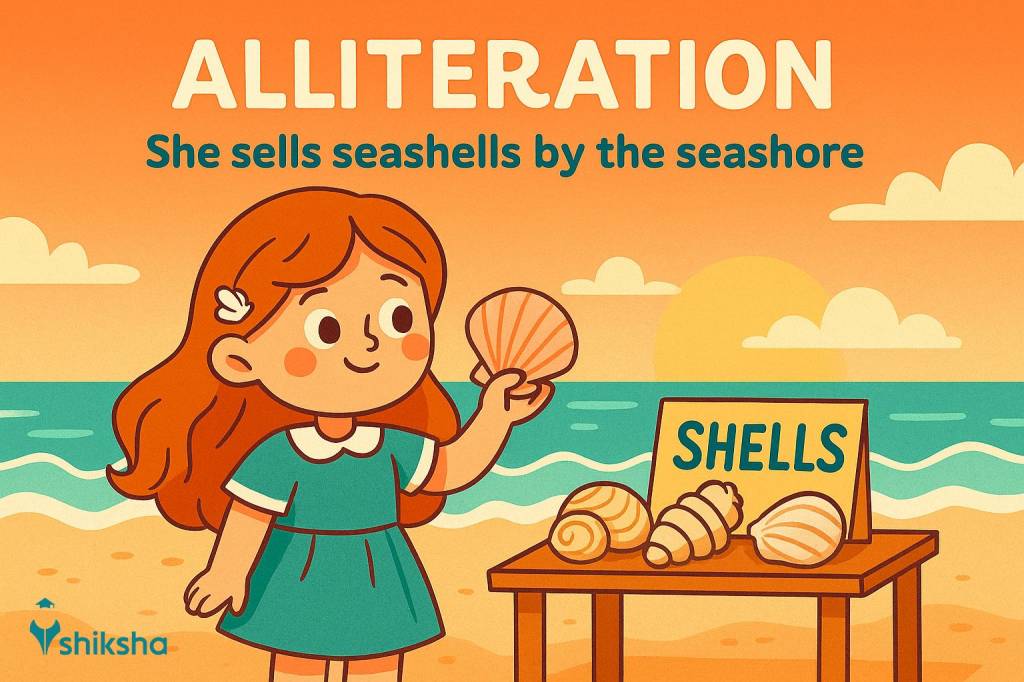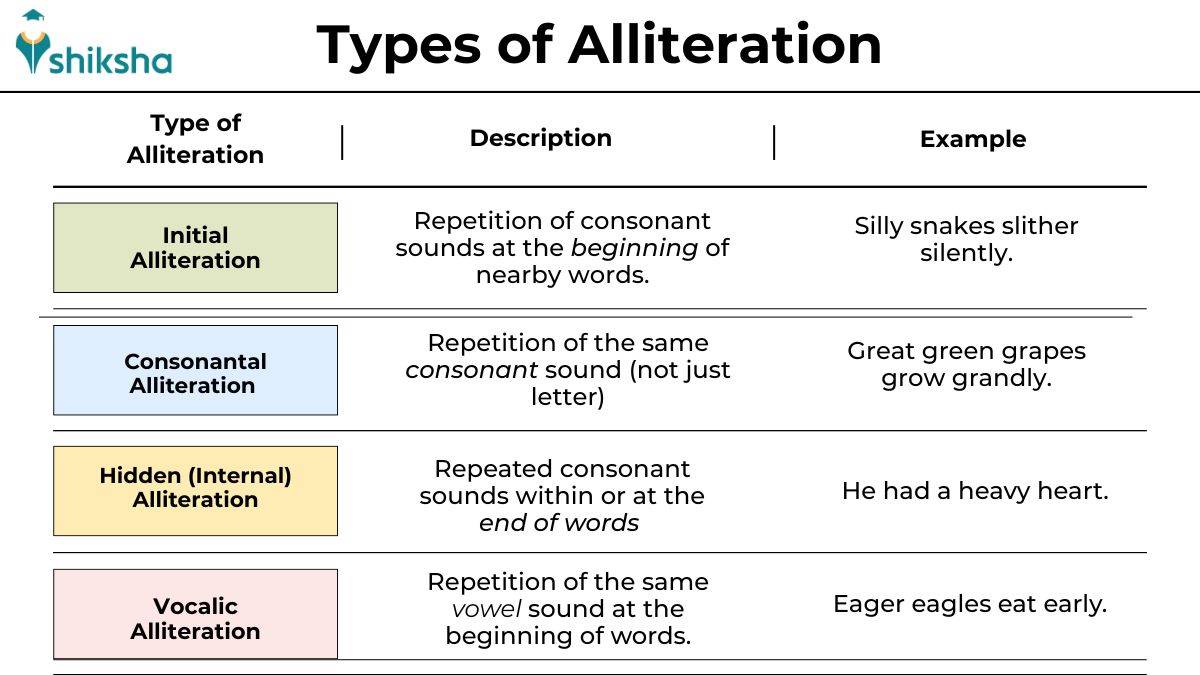
Languages are a beautiful mix of a multitude of components that bring a certain flavour and depth to sentences. One such core component is Alliteration. It is a powerful literary device often used in English grammar to add a rhythm, musicality and enhance the flavour of an otherwise plain sentence. Alliteration is the repetition of the same initial consonant sound in closely connected words or a single sentence.
Alliterations come in handy, especially when writing a poem, prose, or a piece of literature, as they create a phonetic repetition. Usage of alliteration in a sentence or piece of literary body makes it more engaging, catchy, and memorable. In this article, you’ll learn all about the definition of alliteration, types, examples of alliteration, how to use alliteration in a sentence, and practice questions with answers.
- What is Alliteration?
- Definition of Alliteration
- Why is Alliteration Important in English?
- Examples of Alliteration in Real Life
- Types of Alliteration in Grammar
- Tips to Use Alliteration in Sentences
- Best Books for Alliteration in English Grammar
- Practice Questions on Alliteration with Answers
- FAQs on Alliteration in English Grammar
What is Alliteration?
In the simplest terms, alliteration is a figure of speech used when there’s a repetition of the same initial consonant in words that are closely related. This stands true for the words which start with the same sound and not just the letters. Although mostly seen in poetry, alliteration is also a commonly seen literary device in songs, raps, and daily conversations. Alliteration is also called as head rhyme and initial rhyme due to the rhyme and same sounds at the start of the words.
Example:
- Peter Piper picked a peck of pickled p
- Seven states
- PayPal
Definition of Alliteration
As per the Oxford Dictionary, alliteration is defined as “the use of the same letter or sound at the beginning of words that are close together.”
Example: Sing a song of sixpence.
The Merriam-Webster Dictionary defines alliteration as “the repetition of usually initial consonant sounds in two or more neighbouring words or syllables.”
Pronunciation: /əˌlɪtəˈreɪʃn/
Word Origin: early 17th century: from medieval Latin alliteratio(n-), from Latin ad- (expressing addition) + littera ‘letter’.
Also Read:
Why is Alliteration Important in English?
Alliteration in English is more than a poetic touch or a clever device used to create fun tongue-twisters. It plays an important role in building grammar and vocabulary among the learners. In addition to being a literary device, alliteration also seeps into advertising, daily conversations, and creative writing. Let us see some pointers on the importance of alliteration in English:
Alliteration Adds Rhythm and Musicality to Sentences
One of the key “powers” of alliteration is to add rhythm and musical flow. You must have noticed how a lot of rap songs use alliteration to make the lyrics flow more naturally. Similarly, it adds a delicate touch to both the speech and writing. This makes the sentences catchy and engaging.
E.g.:
“The wind whispered whimsically through the wide windows”.
Notice the repetition of the “w” sound that gives a soft imagery and a flowing cadence to the sentence.
It Improves Memory & Retention Abilities
The human brain is wired to recognise patterns, and alliteration creates a rather predictable pattern of sound. This helps the readers/ listeners to easily remember the phrases. This is also a go-to move in a lot of marketing campaigns. Some common examples are: Coca-Cola, Krispy Kreme, Bath & Body, etc.
Alliteration Adds Personality and Style to Writing
Alliteration is a poetic device that adds a distinct personality and flavour to any sentence. Whether you’re composing a song, writing prose, a poem, or simply a description of something mundane, using alliteration in sentences tastefully can inject life into the sentences.
E.g:
Sentence without alliteration: She walked slowly through the forest.
Sentence with alliteration: She wandered wearily through the whispering woods.
Also Read: Examples of English Sentences
It Improves Language Play for Learners
If you’re a student looking to improve English grammar or simply someone keen on brushing up your vocabulary and adding a stylistic flair to your daily conversations, then alliteration may be what you’re looking for.
Examples of Alliteration in Real Life
Alliteration isn’t just a topic tucked away in English classrooms or poetry. It’s a figure of speech of grammar that we use quite often in our everyday conversations, whether intentionally or unintentionally. Let’s take a look at some examples of alliteration used in real life:
Alliteration used in brand names:
- Coca-Cola
- Dunkin’ Donuts
- Pepsi Perfect
- Best Buy
Alliteration used in Tongue Twisters:
One of the common examples of alliteration can be found in tongue-twisters. Check out the following examples to get a better understanding:
- Betty Botter bought some bitter butter…
- How much wood would a woodchuck chuck w.
Alliteration in Song Lyrics
Musicians often use alliteration to build a musical cadence that carries a good flow and emotion into their lyrics. Repeating consonant sounds helps lyrics feel smoother, making them easier to sing along with. Let’s look at some examples of alliteration in songs:
Taylor Swift: “Gorgeous, graceful, golden”
Let it Be by The Beatles: “Whisper words of wisdom, let it be.”
Helplessly Hoping by Stephen Hills: “Helplessly Hoping her harlequin hovers nearby”
That’s Life by Frank Sinatra: “I’ve been a puppet, a pirate, a poet, a pawn, and a king”.
Alliteration in Everyday Speech and Idioms
Without even knowing, we do end up using alliteration in everyday speech. It adds a sense of style and humour to everyday conversations. Some common phrases are:
- Right as rain
- Home sweet home
- Jump for joy
- Busy as a bee
- Good as gold
- Trick or treat
Types of Alliteration in Grammar
Alliteration typically only has one main type, i.e., repetition of consonant sounds. However, it can be further classified by effect or placement. Check the image below to know about the types of alliteration in grammar:
Tips to Use Alliteration in Sentences
Using alliteration in your spoken and written English can boost your vocabulary and communication skills by a mile. Find below some tips that can help you use alliteration in your sentences seamlessly:
Tip #1: Match the Mood and Tone
Use alliteration that complements the emotion or theme of your sentence, instead of going against it.
Example: “Silly snakes slither silently in slimy ways” has a playful tone.
Tip #2: Do not Overuse the Alliteration
One common error that people make is overusing alliteration where it is not used. A little alliteration goes a long way. Overusing it can come off as unnatural and forceful. Use it sparingly in a tasteful manner. Remember to not use alliteration in every word of a sentence as it can come off as tacky. Instead, leave a word or two in between.
Example:
Overuse of alliteration: “Crystal clear, cleverly crafted creative candy”
Tip #3: Pick Vivid and Impactful Words
Picking the right word is essential in creating a rhythmic flow which carries the right amount of impact. When using alliteration in your writing, try to use words that not only go well with one another, but are also strong.
Example: Bold battles bathed with blood bring bravery.
Tip #5: Use Alliteration in Poem, Prose, Literature
The most common usage of alliteration is to use it in poems, prose, and other literary pieces you create. If you are an aspiring writer or a literature enthusiast who is keen on making your own works, then incorporating alliteration into your writing can be a key tool in making your work look more engaging.
Example:
- She stood by the seashore as the soft ripples of water caressed her feet.
- Wandering through the woods, hearing the faint whispers of nature, made me wonder whether I would make it to the end.
Also Read:
| Examples of Personification in English | What are Metaphors? | When to Use an Apostrophe? |
| What is Similie in Grammar? | Common Puns | What is Euphemism? |
Best Books for Alliteration in English Grammar
If you’re looking to master alliteration in grammar, then practice exercises may be the solution you’re looking for. You can purchase these books at your nearby bookstore or online through any trusted publishers/ manufacturers. Check out the best books for alliteration in English:
| Book |
Author/ Publishers |
|---|---|
| Alliteration & Sound Changes in Early English |
Cambridge University Press 2003 |
| Alliteration Here & There |
Dominic J Davis |
| If You Were Alliteration (Word Fun) |
Trisha Speed Shaksan |
To download the alliteration in grammar PDF, you can simply look it up online.
Practice Questions on Alliteration with Answers
FAQs on Alliteration in English Grammar
Commonly asked questions
In English grammar, alliteration is a figure of speech used when there's a repetition of the same initial consonant in words that are closely related. For example: “wind whistled wildly” repeats “w” sound, making the literary device used an alliteration.
There are three types of alliteration:
- Initial Alliteration
- Hidden Alliteration
- ·Consonantal Alliteration
Alliteration is used when there's a repetition of initial consonant sounds, while the rhyme is the repetition of ending sounds in words. Alliteration is also called as head rhyme or initial rhyme for the same reason.
Check out the following list to know about some examples of alliteration in English:
- Mickey Mouse
- Fast & Furious
- Cold, Crisp & Clear
- PayPal
- Bustling Bees
- Whistling winds
- Peter Pieper picked a peck of pickled peppers.
English Figures of Speech Exam
Student Forum
Other Class 10th English Chapters
- English Past Tense
- English Idioms
- English Punctuation
- English Analogy
- English Interjections
- English Prefixes
- English Adjectives
- English Future Continuous Tense
- English Letter Writing
- English Suffix
- English Grammar
- English One Word Substitution
- English Mood
- English Direct and Indirect Speech
- English Figures of Speech
- English Composition
- English Para Jumbles
- English Reading Comprehension
- English Sentences
- English Auxiliary and Modal Verbs
- English Formation of Words
- English Precis Writing
- English Nouns
- English Adverbs
- Conjunctions
- English Prepositions
- English Verbs
- English Paraphrasing
- English Articles
- English Subject and Predicate
- English Pronouns
- English Tenses
- English Active and Passive Voice
- English Vocabulary
- English Subject Verb Agreement
- English Phrases
- English Synonyms
- English Etymology and Roots
- English Spelling Rules
- English Parts of Speech
- English Gerunds


